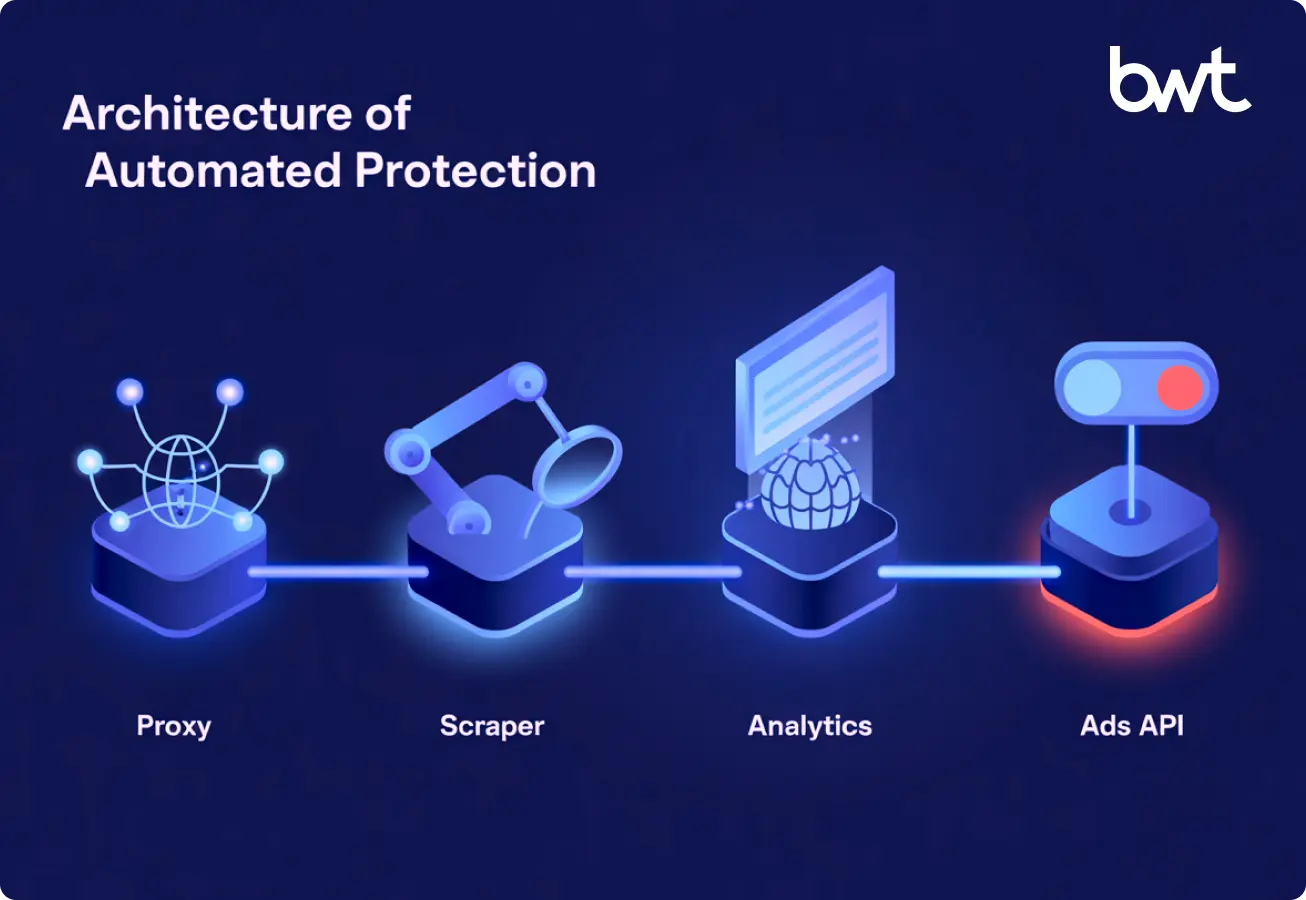Competitors actively bid on branded keywords in search results. This practice creates direct, measurable risks to revenue, making the protection of digital brand assets essential for market success.
The Shield-360 framework provides executives with a practical, integrated architecture for addressing online brand threats and protecting their brand name, reputation, and market share.
This roadmap explains how to protect your brand immediately, strengthen brand protection efforts. Leaders adopt multi-stage defense strategies, transitioning from slow manual checks to custom web scraping as a key evolution. Begin by reviewing current methods to identify areas for improvement.
Executive Directive: Prioritize Real-Time Defense
Executives must deploy technology to protect their brand, moving beyond slow, reactive legal strategies. Research shows brand bidding can divert up to 30% of high-intent website traffic. This key metric ties defense strategies directly to financial risk.
Basic monitoring tools are sufficient only for organizations with a very low risk of exposure. For large enterprises, mandating the development or acquisition of proprietary detection systems is critical. These tailored tools ensure a robust and continuous defense, maximizing asset value.
Key Actions for Leadership
- Audit Protocols: Clearly identify all current brand protection policies and systematically evaluate their effectiveness. Quantify the financial vulnerabilities associated with each gap.
- Reallocate Capital: Intentionally shift resources to purchase and implement real-time technological defenses. Ensure funding is immediately available for urgent brand protection needs
- Optimize Investment: Establish a recurring process to assess losses from brand bidding. Track ongoing protection costs to inform and adjust budget decisions.
- Institutionalize Monitoring: Build and integrate a custom system into ongoing business planning. Assign responsibility for the daily operation to secure income and market share.
Our approach is simple: We convert the complexity of custom SERP data into quantifiable business insight. This allows executives to see the exact financial value of every brand protection measure and make decisions based on certainty, not guesswork
— Olesia Holovko, CMO
Brand Bidding: The Immediate Revenue Drain

Competitors bid on your branded keywords, pushing their ads above your organic and paid results to steer customers toward their own rivals. Companies must act quickly to prevent profit erosion and protect their brand.
Analysts require competitive analysis to precisely mirror the Search Engine Results Page (SERP) as a real customer sees it. Running checks every hour is strongly suggested. This high-frequency monitoring counters the extreme volatility of paid search placements, as competitors’ ads appear and vanish quickly, stealing substantial traffic volumes in moments. Executives conduct cost-benefit analyses to pinpoint optimal monitoring frequency and ROI.
Legal Foundation: Enabling Technological Defense
Technology-based defense requires firm legal ground. Securing legitimate intellectual property rights remains the first and most crucial step. Without registered trademarks, organizations cannot demand the removal of unauthorized advertisements, which severely limits enforcement actions.
Trademark Registration: Securing Rights
Trademark registration legally protects your brand name, logo, and core identity features. This process stabilizes business continuity. It grants the exclusive right to use your brand for all products and services.
Executives protect your brand globally by registering trademarks in all jurisdictions. Skipping local registration blocks action against local platforms—legal rights secure long-term capital stability.
Policy Gaps: The Google Ads Loophole
Google Ads provides a route for trademark owners to report misuse, typically blocking creative infringements quickly. However, Google frequently permits competitors to use your registered trademark as a keyword, provided they omit the name from the ad’s headline or description text. This policy loophole necessitates a fast, technology-based countermeasure to protect your brand online.
Non-Bidding Threats
Brand bidding is one digital risk; impersonation is another. Companies must guard against phishing sites and domain squatters. Automated tools quickly detect unauthorized domains, enabling rapid responses to maintain client trust and protect your brand online.
Automated Defense: Mitigating Real-Time Revenue Risk

Legal action proves too slow to stop determined brand bidders. Competitors exploit enforcement delays consistently. Swift, automated measures become essential for defending your brand and revenue in real-time.
Organizations deploy systems that trigger paid ads only when competitor brand bidding is detected, saving resources. The system keeps your brand protected, and real-time KPIs like ‘brand traffic preserved’ on executive dashboards justify continued investment.
SERP Data Distortion
Trustworthy data drives wise brand protection choices. Search results are constantly changing due to factors such as location, search history, and device type. The SERP observed internally may not reflect the actual customer experience. Reliance on inaccurate data causes poor decisions and wastes marketing dollars. Leaders must understand how personalization affects results to ensure defense accuracy.
Geolocation: The Uule Mandate
Location makes a critical difference in ad ranking and display. Competitors often target brand bidding to specific regions. Global brand protection requires precise geotargeting.
Technologists use Uule codes, which are special digital coordinates embedded in Google search URLs. These codes effectively act as the system’s “Google GPS,” tricking the search engine into believing the request is coming from any city or country you choose. This is critical because it ensures your monitoring system sees the exact SERP your customer sees in that specific location. Using the correct Uule code is crucial to replicating the customer’s exact search experience and identifying hidden competitors.
Scenario: A competitor only targets your brand name in Dallas, Texas.
- Defense without Uule: Monitoring from your New York headquarters shows no infringement. Threat missed.
- Defense with Uule: The system attaches the specific Dallas code to the search request. The SERP is returned as if you were physically in Dallas, instantly revealing the competitor’s ad.
Third-Party Data: Managing the Accuracy Deficit

Many external companies sell search result monitoring tools, but their data often lacks the necessary reliability and accuracy. In our benchmark tests, three leading providers agreed only 70% of the time. This means executives receive 30% potentially wrong or confusing information.
Third-party tools frequently fall below 70% accuracy. This wastes ad budget and removes market positioning opportunities. Accepting a 30% margin of error introduces substantial operational risk. Custom solutions consistently deliver accuracy above 90%. Organizations require specialized technological infrastructure for collecting and reporting.
| Provider | Match Accuracy | Update Frequency | Business Consequence |
| Data Provider 1 | 70% | 6 times/day | Delays response; increases competitor exposure by 18%. |
| Data Provider 2 | 75% | 12 times/day | Provides moderate visibility; acceptable for non-critical markets. |
| Data Provider 3 | 68% | On-Demand | High risk of missed threats; compromises to defend your branding ability. |
The Core Infrastructure Investment to Defending Your Brand
Organizations gain complete control by building a proprietary data collection system. They first assess current keyword monitoring coverage, then design or integrate the new platform. Bypassing third-party limitations enables detailed, real-time protection for your brand.
Executives, protecting their brand, must allocate strategic investment for a custom SERP monitor as a core business essential. This system underpins operational strength and profit protection. Prioritize best-in-class proxy servers to maintain data quality and support sound decision-making.
Platform Components: Automation Framework

The brand protection system is constructed from four tightly linked parts :
- Proxy Management System: This module handles IP rotation, verifies data quality, and manages geographical targeting.
- High-Speed Web Scraper: This component executes requests against the Google SERP, mimicking realistic user behavior.
- Analytical Module: It processes raw data, applies business logic, and automatically identifies threat triggers.
- Google Ads API Integration Module: This module acts on analytical findings, sending direct commands to switch campaigns on or off automatically.
This integrated setup enables companies to respond promptly to market shifts, minimizing wasted budget and ensuring your brand’s protection is reliable.
Operational Resilience: Beyond the First Deployment

Comprehensive SERP monitoring gives executive teams deep visibility into search activity. This empowers them to address brand bidding and digital risks before problems escalate. Defending your brand requires proactive action across all areas of your business.
Fraudulent ads redirect high-value customers to phishing or unauthorized sites. The SERP monitoring system detects non-compliant ads immediately. Investing in online brand protection directly reduces the risk of customer churn.
Leaders establish a clear, structured plan for continuous vigilance. This includes scheduled data audits and routine defensive technology upgrades. Organizations direct resources toward a scalable defense system, ensuring operational resilience and long-term market leadership.
To effectively defend your branding, real-time data is non-negotiable. Our custom scraping layer bypasses cloaking techniques and monitors hundreds of locations simultaneously. This level of granular, reliable data is the single biggest differentiator between merely reporting a violation and actively stopping the financial bleeding.
— Oleg Boyko, GroupBWT
Conclusion
Brand bidding is a direct, calculated attack on your core business value. Relying on partial data or manual checks is no longer sufficient to defend your brand.
By deploying a custom, automated defense solution built on precision Web Scraping and a robust counter-bidding framework, you stop revenue leakage, control your customer journey, and significantly reduce unnecessary ad spend. This is the difference between hoping to know how to protect your brand and establishing a quantifiable, operational safeguard that gives you a guaranteed competitive edge.
It’s time to take decisive action on how to defend your brand and ensure your brand equity remains profitable.
Key Takeaways for Leadership
- Financial Impact: Revenue losses often exceed the system’s cost, accelerating the payback period (typically 12-24 months).
- Accuracy: Custom systems deliver over 90% accuracy, addressing the 30% blind spot of third-party tools.
- Competitive Edge: Automated counter-bidding provides an instant response, which neither legal nor manual methods can match.
The true measure of a robust defense system is its ability to scale and sustain. We don’t just solve today’s problem; we build the frameworks that anticipate and neutralize tomorrow’s attack vectors. If you are serious about how to defend your brand long-term, custom, resilient engineering is the only path forward for defending your favorite brands.
— Dima Naumenko, GroupBWT
Schedule a free 30-minute consulting session now and keep your brand protected.
FAQ
-
How to protect your brand name?
You must secure Trademark Registration globally for your brand name to establish legal enforcement rights. Technologically, deploy a custom, automated Shield-360 monitoring system that uses Uule codes for precise geolocation to detect competitor brand bidding in real-time. This system then instantly triggers counter-ads to stop revenue leakage, providing a robust safeguard that legal action cannot match in speed.
-
How to do it protect your brand online?
Effectively protecting your brand online requires combining the legal foundation (Trademark Registration) with automated technological defense. Deploy a custom system to accurately detect competitor brand bidding and non-bidding threats (like domain squatters). This automated defense instantly triggers countermeasures, using precise data to halt revenue loss and ensure you keep your brand protected from digital attacks.
-
Is brand bidding legal?
Yes, often it is. If the organization lacks a registered trademark in a region, or if the competitor avoids using the trademark in the ad text, Google permits the practice. This legal gray area ensures brand defense relies heavily on technology, not just law.
-
What level of loss justifies a сustom solution?
A custom solution becomes financially sensible when revenue losses from brand bidding exceed the system’s estimated operating cost. This threshold typically sits near $30,000 per month for a global-scale operation (based on GroupBWT client data).
-
What is the most significant advantage of a сustom data solution?
The main benefits are accuracy (over 90%) and response speed. This high level of precision enables companies to avoid unnecessary advertising expenditures. Precision cuts budget waste by 40% (based on GroupBWT client data).
-
How quickly can a custom SERP monitoring system be deployed?
Building and stabilizing the proprietary proxy architecture and scraper can take anywhere from 3 to 6 months. Operational leadership includes this lead time in strategic planning.
-
How can small companies protect their brand without a large budget?
Small companies start by using cheaper, ready-made SERP providers for spot-checking. They accept the 70% data accuracy trade-off as a temporary, calculated risk.






